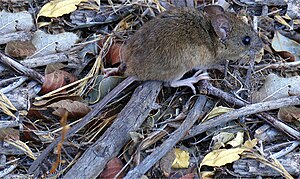Dwarf rice rats
| Dwarf rice rats | ||||||||||||
|---|---|---|---|---|---|---|---|---|---|---|---|---|

|
||||||||||||
| Systematics | ||||||||||||
|
||||||||||||
| Scientific name | ||||||||||||
| Oligoryzomys | ||||||||||||
| Bangs , 1900 |
The dwarf rice rats ( Oligoryzomys ) are a genus of rodents from the group of New World mice that lives in Central and South America . They include 18 types.
features
Dwarf rice rats are relatives of the rice rats and are similar to them, but are smaller. They reach a head body length of 7 to 11 centimeters, the tail is very long with 9 to 16 centimeters. The weight is 9 to 40 grams. Their fur is yellowish-brown or brownish in color on the upper side, the underside is light gray. The muzzle is pointed and the ears are oval.
distribution and habitat
These rodents are native to Central and South America, and their range extends from Mexico to Tierra del Fuego . They prefer areas with dense undergrowth and occur in forests and scrublands, but also in gardens and plantations.
Way of life
Dwarf rice rats are nocturnal. They are mostly on the ground, but they can climb well. During the day they retreat to self-made grass nests. Outside of the mating season, they live solitary. Their diet consists of seeds, fruits and insects.
Dwarf rice rats and humans
These rodents sometimes invade plantations or granaries and are considered pests. Most species are not endangered according to the IUCN . The species O. victus , which was endemic to the Caribbean island of St. Vincent , is only known from a specimen found in 1897 and is believed to be extinct. The population of the long-tailed pygmy rice rat O. longicaudatus in the southern cone of South America is considered to be the most important reservoir of the Andes - hantavirus , which can be transmitted to humans directly or via other rodents through the animal's feces, urine and saliva and the very dangerous lung form of the hantavirus disease hantavirus Pulmonary Syndrome (HPS).
The species
There are 18 types:
- Oligoryzomys andinus lives in the Andean regions in Peru and Bolivia.
- Oligoryzomys arenalis is only known from the coastal plains of Peru.
- Oligoryzomys brendae lives in north-western Argentina.
- Oligoryzomys chacoensis occurs in arid regions from southeastern Bolivia to northern Argentina.
- Oligoryzomys delticola lives in eastern Argentina, Uruguay and southern Brazil.
- Oligoryzomys destructor lives in the Andean region from southern Colombia to northern Argentina.
- Oligoryzomys eliurus occurs in central and eastern Brazil.
- Oligoryzomys flavescens is distributed from southeastern Brazil via Paraguay and Uruguay to central Argentina.
- Oligoryzomys fornesi lives in northeast Argentina, Paraguay, and southern Brazil.
- Yellow-brown pygmy rice rat ( Oligoryzomys fulvescens ) is common from Mexico to northern Brazil.
- Oligoryzomys griseolus lives in mountain regions in eastern Colombia and western Venezuela.
- Oligoryzomys longicaudatus is common in Chile and Argentina.
- Oligoryzomys magellanicus occurs in Patagonia and Tierra del Fuego.
- Oligoryzomys microtis lives in the Amazon basin.
- Oligoryzomys nigripes lives in Paraguay, southern Brazil and northern Argentina.
- Oligoryzomys pachecoi lives in Bolivia.
- Oligoryzomys stramineus lives in central and eastern Brazil.
- Oligoryzomys vegetus occurs in Costa Rica and Panama.
- Oligoryzomys victus lived on the Caribbean island of St. Vincent and is believed to be extinct.
literature
- Ronald M. Nowak: Walker's Mammals of the World. 2 volumes. 6th edition. Johns Hopkins University Press, Baltimore MD et al. 1999, ISBN 0-8018-5789-9 .
- Don E. Wilson , DeeAnn M. Reeder (Eds.): Mammal Species of the World. A taxonomic and geographic Reference. 2 volumes. 3. Edition. Johns Hopkins University Press, Baltimore MD 2005, ISBN 0-8018-8221-4 .
- Marcelo Weksler, Alexandre Reis Percequillo, Robert S. Voss: Ten new genera of oryzomyine rodents (Cricetidae: Sigmodontinae). In: American Museum Novitates. No. 3537, 2006, ISSN 0003-0082 , pp. 1-29, online .
Web links
- Endangerment level of the individual species in the IUCN Red List of Threatened Species .
Individual evidence
- ^ Carlos Martínez: Ojo con el Virus Hanta. In: InfoGate , February 2, 2017, accessed June 11, 2018.
- ↑ Constanza Castillo H., Gonzalo Ossa A .: Síndrome pulmonar por hantavirus Andes en Chile. In: Revista chilena de enfermedades respiratorias , Volume 18, No. 1 (January 2002), doi : 10.4067 / S0717-73482002000100005 .